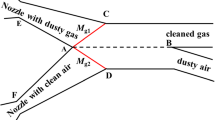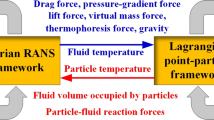Abstract
A two-phase flow with high Reynolds numbers in the subsonic, transonic, and supersonic parts of the nozzle is considered within the framework of the Prandtl model, i.e., the flow is divided into an inviscid core and a thin boundary layer. Mutual influence of the gas and solid particles is taken into account. The Euler equations are solved for the gas in the flow core, and the boundary-layer equations are used in the near-wall region. The particle motion in the inviscid region is described by the Lagrangian approach, and trajectories and temperatures of particle packets are tracked. The behavior of particles in the boundary layer is described by the Euler equations for volume-averaged parameters of particles. The computed particle-velocity distributions are compared with experiments in a plane nozzle. It is noted that particles inserted in the subsonic part of the nozzle are focused at the nozzle centerline, which leads to substantial flow deceleration in the supersonic part of the nozzle. The effect of various boundary conditions for the flow of particles in the inviscid region is considered. For an axisymmetric nozzle, the influence of the contour of the subsonic part of the nozzle, the loading ratio, and the particle diameter on the particle-flow parameters in the inviscid region and in the boundary layer is studied.
Similar content being viewed by others
REFERENCES
B. Y. Wang and I. I. Glass, “Compressible laminar boundary layer flows of a dusty gas over a semi-infinite flat plate,” J. Fluid Mech., 186, 223–441 (1988).
B. Y. Wang and I. I. Glass, “Boundary layer flows behind constant speed shock waves moving into a dusty gas,” Shock Waves, 1, No.3, 135–144 (1991).
E. Outa, K. Tajima, M. Kobayashi, and S. Mimura, “Boundary layer of a non-equilibrium gas-particle mixture modified by particle lifting motion behind a shock front,” in: Proc. of the 17th Int. Symp. on Shock Waves and Shock Tubes (Betlehem, PA, July 17–21, 1989), American Institute of Physics (1990), pp. 770–775.
R. Saurel, E. Daniel, and J. C. Loraud, “Two-phase flows: second-order schemes and boundary conditions, ” AIAA J., 32, No.6, 1214–1221 (1994).
N. Thevand, E. Daniel, and J. C. Loraud, “On high-resolution schemes for solving unsteady compressible two-phase dilute viscous flows,” Int. J. Numer. Mech. Fluids, 31, 681–702 (1999).
N. Thevand and E. Daniel, “Numerical study of the lift force influence on two-phase shock tube boundary layer characteristics,” Shock Waves, 12, No.4, 279–288 (2002).
S.-W. Kim and K.-S. Chang, “Reflection of shock wave from a compression corner in a particle-laden gas region,” Shock Waves, 1, No.1, 65–73 (1991).
H. Sakakita, A. K. Hayashi, and A. I. Ivandaev, “Numerical simulation of shock wave interaction with powder layers,” in: Proc. of the 18th Int. Symp. on Shock Waves and Shock Tubes (Sendai, Japan, July 21–26, 1991), Vol. 1, Springer-Verlag, Berlin-Heidelberg (1991), pp. 563–568.
B. Y. Wang, Q. S. Wu, C. Wang, et al., “Shock wave diffraction by a square cavity filled with dusty gas, ” Shock Waves, 11, No.1, 7–14 (2001).
T. R. Amanbaev, “Lifting of disperse particles from a cavity behind the front of an unsteady shock wave with a triangular velocity profile,” J. Appl. Mech. Tech. Phys., 44, No.5, 634–639 (2003).
I. M. Vasenin and A. D. Rychkov, “Numerical solution of the problem for a gas-particle flow in an axisymmetric Laval nozzle,” Izv. Akad. Nauk SSSR, Mekh. Zhidk. Gaza, No. 5, 178–181 (1975).
A. A. Glazunov and A. D. Rychkov, “Nonequilibrium two-phase flows in axisymmetric Laval nozzles,” Izv. Akad. Nauk SSSR, Mekh. Zhidk. Gaza, No. 6, 86–91 (1977).
L. E. Sternin, Fundamentals of Gas Dynamics of Two-Phase Nozzle Flows [in Russian], Mashinostroenie, Moscow (1974).
I. M. Vasenin, V. A. Arkhipov, V. G. Butov, et al., Gas Dynamics of Two-Phase Nozzle Flows [in Russian], Izd. Tomsk. Univ., Tomsk (1986).
A. D. Rychkov, Mathematical Modeling of Gas-Dynamic Processes in Channels and Nozzles [in Russian], Nauka, Novosibirsk (1988).
M. Sommerfeld, “Expansion of a gas/particle mixture in supersonic free jet flow,” Z. Flugwiss. Welraumforsch., 11, No.2, 87–96 (1987).
A. A. Mostafa, H. C. Mongia, V. G. McDonell, and G. S. Samuelsen, “Evolution of particle-laden jet flows: A theoretical and experimental study,” AIAA J., 27, No.2, 167–183 (1989).
N. N. Yanenko, R. I. Soloukhin, A. N. Papyrin, and V. M. Fomin, Supersonic Two-Phase Flows under Conditions of Velocity Nonequilibrium of Particles [in Russian], Nauka, Novosibirsk (1980).
H. C. Yee, R. F. Warming, and A. Harten, “Implicit total variation diminishing (TVD) schemes for steady-state calculations,” J. Comp. Phys., 57, 327–360 (1985).
G. Seider, Numerische Untersuchung Transsonischer Stromungen, Aerodyn. Inst., RWTH, Aachen, Germany (1991).
A. N. Kraiko and S. M. Sulaimanova, “Two-fluid flows of a mixture of a gas and solid particles with “sheets” and “strings” arising in the flow around impermeable surfaces,” Prikl. Mat. Mekh., 47, No.4, 619–630 (1983).
R. F. Cuffel L. H. Back, and P. F. Massier, “Transonic flow field in a supersonic nozzle with small throat radius of curvature,” AIAA J., 7, 1364–1366 (1969).
V. N. Vetlutskii and V. L. Ganimedov, “Calculations of a compressible flow in a compression corner at high Reynolds numbers,” Aeromekh. Gaz. Dinam., No. 2, 10–20 (2003).
R. Courant, Partial Differential Equations, New York (1962).
V. M. Agranat and A. V. Milovanova, “Calculation of friction and heat transfer in a dusty boundary layer,” in: Mechanics of Reactive Media and Its Applications [in Russian], Nauka, Novosibirsk (1989), pp. 164–170.
L. M. Vetlutskaya and V. N. Vetlutskii, “Calculation of a spatial compressible laminar boundary layer on a pointed body,” in: Numerical Methods of Mechanics of Continuous Media (collected scientific papers) [in Russian], Vol. 17, No.5, Inst. Theor. Appl. Mech., Sib. Div., Russian Acad. of Sci., Novosibirsk (1986), pp. 25–42.
Author information
Authors and Affiliations
Additional information
__________
Translated from Prikladnaya Mekhanika i Tekhnicheskaya Fizika, Vol. 46, No. 6, pp. 65–77, November–December, 2005.
Rights and permissions
About this article
Cite this article
Vetlutskii, V.N., Ganimedov, V.L. & Muchnaya, M.I. Investigation of a Gas Flow with Solid Particles in a Supersonic Nozzle. J Appl Mech Tech Phys 46, 824–834 (2005). https://doi.org/10.1007/s10808-005-0140-3
Received:
Revised:
Issue Date:
DOI: https://doi.org/10.1007/s10808-005-0140-3




